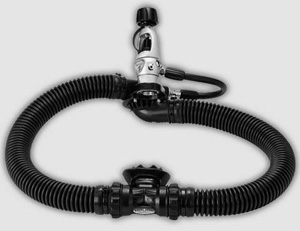Aqua Lung’s “Mistral” RegulatorContents of this Issue: Aqua Lung’s “Mistral” Regulator Scubapro MK20 Cracking Problem Reported Editorial Office: Ben Davison Publisher and Editor Undercurrent 3020 Bridgeway, Suite 102 Sausalito, CA 94965 high tech nostalgia trip from the June, 2005 issue of Undercurrent
If you’re a diver who still prefers all black wet suits, Duck Feet fins and a straight pipe snorkel, the new Aqua Lung Mistral will have you reminiscing about Lloyd Bridges and Sea Hunt.
You see, it’s a twin hose regulator, a few generations removed from Jacques Cousteau’s original design. But, it’s more than just a retro fashion statement. It has real present-day advantages -- but it’s not all things to all divers. Air from your tank comes to you from the right hose and your exhalation is routed through the left hose so the bubbles escape behind your head . . . a photographer’s wet dream. It’s even quieter than a typical single hose regulator, although not as quiet as a rebreather. The Mistral’s balanced diaphragm first stage, based on the Aqua Lung Titan, is environmentally dry sealed. The downstream second stage is also protected to ward off the effects of frigid or polluted waters, a feature that will appeal to those who have to brave such waters. There are unique considerations when using the Mistral, as I found out when I tested it. The first and second stages are attached to one another, so both ride on the diver’s back. This means that there’s six inches or more between the mouthpiece and the second stage diaphragm (unlike single hose regulators, where the second stage is integrated into the mouthpiece). Because of the resulting differential in ambient pressure between the demand and supply points, the regulator breathes hard when swimming face down. This characteristic runs contrary to the current trend in regulators: the easier breathing the better. The unit I dove with was set to factory specs, but an authorized technician can adjust the intermediate pressure a bit. When inverted, the Mistral freeflows because the pressure on the second stage diaphragm is greater than that on the mouthpiece. The flow was strong enough to part my lips and let water into my mouth when I rolled over with it. Eventually I grew accustomed to the sudden rush of air and could control it. But, when I took the mouthpiece out for a surface swim on my back, the only way to stop the constant free flow was to turn off the tank – hardly a practical solution. In the owner’s manual, Aqua Lung recommends keeping the mouthpiece in your mouth “from your entry into the water until you leave the water in order to avoid free-flows.” That would require saving a substantial amount of air for your swim back to the boat or shore. And, it means no buddy breathing. Underwater, I found the unit easy to clear. A gentle roll onto my left side sent all the water from the mouthpiece into the exhalation hose, where I blew a short burst of air to expel it (there is no purge valve). The mouthpiece seemed bulky, but my dealer told me the lip guard could be removed, or a custom mouthpiece could be installed. A pair of adjusting lugs allowed some minor repositioning of the mouthpiece against my gums. The Mistral’s first stage is fitted with one high pressure port and four medium pressure ports, so it can support a submersible pressure gauge, BCD and dry suit inflators, and an octopus. Air travels from the first stage to the second via a 9.5- inch medium pressure hose, with a 25- inch long hose available for cold water diving. The longer hose acts as a heat exchange device. Gas cools as it expands, so air coming into the first stage from the tank can be as cold as 25F. The longer it travels to the second stage, the more it warms up, even in icy water. The 25-inch hose allows the unit to meet the European norm for cold water regulators. The suggested retail price for the Mistral is $900, making it about twice as expensive as Aqua Lung’s Titan Glacia cold-water single hose regulator; so it’s hardly an impulse buy. But if you’re a cold water diver, or just tired of peering through a bubble curtain underwater and don’t want to switch to a rebreather, you may find it worth the premium. |

I want to get all the stories! Tell me how I can become an Undercurrent Online Member and get online access to all the articles of Undercurrent as well as thousands of first hand reports on dive operations world-wide
| Home | Online Members Area | My Account |
Login
|
Join
|
| Travel Index |
Dive Resort & Liveaboard Reviews
|
Featured Reports
|
Recent
Issues
|
Back Issues
|
|
Dive Gear
Index
|
Health/Safety Index
|
Environment & Misc.
Index
|
Seasonal Planner
|
Blogs
|
Free Articles
|
Book Picks
|
News
|
|
Special Offers
|
RSS
|
FAQ
|
About Us
|
Contact Us
|
Links
|
3020 Bridgeway, Ste 102, Sausalito, Ca 94965
All rights reserved.


